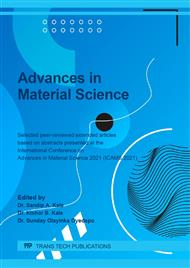[1]
Tuan D. Ngo, Alireza Kashani, Gabriele Imbalzano, Kate T. Q. Nguyen and David Hui. Additive manufacturing (3D printing): A review of materials, methods, applications and challenges. Composites Part B: Engineering Volume 143, 15 June 2018, Pages 172-196.
DOI: 10.1016/j.compositesb.2018.02.012
Google Scholar
[2]
Pavan Kumar Penumakala, JoseSanto, Alen Thomas. A critical review on the fused deposition modeling of thermoplastic polymer composites. Composites Part B: Engineering, Volume 201, 15 November 2020, 108336.
DOI: 10.1016/j.compositesb.2020.108336
Google Scholar
[3]
Dhruv Maheshkumar Patel. Effects of infill patterns on time, surface roughness and tensile strength in 3D printing. International Journal of Engineering Development and Research 2017, Volume 5, 566-569.
Google Scholar
[4]
Gabriel A.J, Jesse J.F. Evaluation of Infill Effect on Mechanical Properties of Consumer 3D Printing Materials. Advances in Technology Innovation, vol. 3, no. 4, 2018, pp.179-184.
Google Scholar
[5]
Cristian Dudescu and Laszlo Racz. Effects of Raster Orientation, Infill Rate and Infill Pattern on the Mechanical Properties of 3D Printed Materials. Acta Universitatis Cibiniensis - Technical Series, Volume 69 (2017): Issue 1 (December 2017).
DOI: 10.1515/aucts-2017-0004
Google Scholar
[6]
Chamil Abeykoon, Pimpisut Sri-Amphorn, AnuraFernando. Optimization of fused deposition modeling parameters for improved PLA and ABS 3D printed structures. International Journal of Lightweight Materials and Manufacture Volume 3, Issue 3, September 2020, Pages 284-297.
DOI: 10.1016/j.ijlmm.2020.03.003
Google Scholar
[7]
Gordeev EG, Galushko AS, Ananikov VP. Improvement of quality of 3D printed objects by elimination of microscopic structural defects in fused deposition modeling. PLoS ONE (2018) 13(6): e0198370.
DOI: 10.1371/journal.pone.0198370
Google Scholar
[8]
Daniel Frank, Raymond L. Chandra, and Robert Schmitt. An Investigation of Cause-and-Effect Relationships Within a 3D-Printing System and the Applicability of Optimum Printing Parameters from Experimental Models to Different Printing Jobs. 3D printing and additive manufacturing, Volume 2, Number 3, (2015).
DOI: 10.1089/3dp.2015.0010
Google Scholar
[9]
Kovan V., Tezel T., Topal E.S., Camurlu H.E. Printing parameters effect on surface characteristics of 3d printed pla materials. International Scientific Journal Machines. Technologies. Materials. Vol. 12 (2018), Issue 7, pg(s) 266-269.
Google Scholar
[10]
Nadir Ayrilmis. Effect of layer thickness on surface properties of 3D printed materials produced from wood flour/PLA filament Author links open overlay panel. Polymer Testing Volume 71, October 2018, Pages 163-166.
DOI: 10.1016/j.polymertesting.2018.09.009
Google Scholar
[11]
Rafael Thiago Luiz Ferreira, Igor Cardoso Amatte, Thiago Assis Dutra, Daniel Burger. Experimental characterization and micrography of 3D printed PLA and PLA reinforced with short carbon fibers. Composites Part B: Engineering Volume 124, 1 September 2017, Pages 88-100.
DOI: 10.1016/j.compositesb.2017.05.013
Google Scholar
[12]
Calignano, F.; Lorusso, M.; Roppolo, I.; Minetola, P. Investigation of the Mechanical Properties of a Carbon Fibre-Reinforced Nylon Filament for 3D Printing. Machines 2020, 8, 52.
DOI: 10.3390/machines8030052
Google Scholar
[13]
Le, T.-H.; Le, V.-S.; Dang, Q.-K.; Nguyen, M.-T.; Le, T.-K.; Bui, N.-T. Microstructure Evaluation and Thermal–Mechanical Properties of ABS Matrix Composite Filament Reinforced with Multi-Walled Carbon Nanotubes by a Single Screw Extruder for FDM 3D Printing. Appl. Sci. 2021, 11, 8798.
DOI: 10.3390/app11198798
Google Scholar
[14]
Xianhui Zhao, Halil Tekinalp, Xianzhi Meng, Darby Ker, Bowie Benson, Yunqiao Pu, Arthur Ragauskas, Yu Wang, Kai Li, Erin Webb, Douglas J. Gardner, James Anderson, and Soydan Ozcan. Poplar as biofiber reinforcement in composites for large-scale 3D printing. ACS Appl. Bio Mater. 2019, 2, 10, 4557–4570.
DOI: 10.1021/acsabm.9b00675
Google Scholar
[15]
Raymond K.F. Lam, Michael Orozco, Erick Mendieta, Bernard Hunter, and Joseph Seiter. Compressive Mechanical Properties of Three-Dimensional (3D) Printed Thermoplastics.
Google Scholar
[16]
Nur Ameelia Rosli, Rafidah Hasan, Mohd Rizal Alkahari. Effect of default parameters on properties of FDM printed cubes. Proceedings of Mechanical Engineering Research Day 2018, pp.230-232, May (2018).
Google Scholar
[17]
Balakrishnan Subeshan, Abdullah Alonayni, Muhammad M. Rahman, and Eylem Asmatulu, Proc. of SPIE Vol. 10597 105970N-2,.
Google Scholar
[18]
Susan Erica Nace, John Tiernan, Donal Holland, Aisling Ni Annaidh, A comparative analysis of the compression characteristics of a thermoplastic polyurethane 3D printed in four infill patterns for comfort applications, Rapid Prototyping Journal, Volume 27 Number 11, 2021, 24–36.
DOI: 10.1108/rpj-07-2020-0155
Google Scholar



